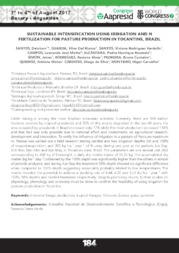Sustainable intensification using irrigation and N fertilization for pasture production in Tocantins, Brazil.
Sustainable intensification using irrigation and N fertilization for pasture production in Tocantins, Brazil.
Author(s): SANTOS, D.; GUARDA, V. D. A.; SANTOS, V. R. V. dos; CAMPOS, L. J. M.; ALCANTARA, P. H. R. de; SIMON, J.; ALVES, R. R.; PEDREIRA, B. C. e; QUEIROZ, FABIANA MATOS; CARDOSO, DIOGO DA SILVA; MONTEIRO, HIGOR CARVALHO
Summary: To verify the influence of irrigation in a pasture of Panicum maximum cv. Massai was carried out a field research testing rainfed and two irrigation depths (SO and 100% of evapotranspiration) and 300 kg ha-1 year-1 of N-urea, during one year at the periods Jun-Sep, Oct-Nov, Dec-Mar and Apr-May, in Tocantins state, Brazil.
Publication year: 2017
Types of publication: Abstract in annals or event proceedings
Observation
Some of Embrapa's publications are published as ePub files. To read them, use or download one of the following free software options to your computer or mobile device. Android: Google Play Books; IOS: iBooks; Windows and Linux: Calibre.
Access other publications
Access the Agricultural Research Database (BDPA) to consult Embrapa's full library collection and records.
Visit Embrapa Bookstore to purchase books and other publications sold by Embrapa.

